The dynamics of heavy-ion fusion reaction involved in the interaction of 12C,14N and 16O projectiles with,59Co, 51V,128Te and165Ho targets at≈3-8MeV/nucleon specific energies was studied. This study focus on the correlation between entrance channel properties and incomplete fusion reaction. The experimentally measured excitation functions of various reaction products populated by complete and/or incomplete fusions of 12C+59Co, 128Te,14N+128Teand 16O+ 51V, 165Hoprojectile-target systems available in the literature. Were compared and analyzed with the predicted excitation functions, using the statistical model code PACE4. For representative non-α-emitting channels, the experimentally measured excitation functions were, in general, found to be in good agreement with the theoretical predictions. However, for α-emitting channels in the present systems, the measured excitation functions were higher than the predictions of the theoretical model code, which may be credited to incomplete fusion reactions at these energies. An attempt was made to approximate the incomplete fusion fraction that explains the relative importance of incomplete fusion processes. The incomplete fusion fraction was found to be sensitive to the projectile energy and mass-asymmetry of the entrance channel.
Keywords: alpha emitted, CF reaction, entrance channel, heavy-ion fusion, ICF reaction, non-alpha emitted
The atomic nuclei consist of proton and neutron and have complicated static and dynamic property.1 Extensively experimentally and theoretical effort over the past century have explained many of the nuclear properties but in spite of these efforts there are still many unresolved problems that motivate further studies. A common method of gaining information about the nuclear property is to perform nuclear reaction (scattering) experiments in which different observable of scattered particles and residue nuclei are measured. A nuclear reaction is considered to be the process in which two nuclear particles (two nuclei or a nucleus and a nucleon) interact to produce two or more nuclear particles (nuclei) and/or γ -rays. Nuclear Physics studies the dynamics of heavy-ion collisions and the structure of nuclei far from stability. Hence the collision of two nucleic a give place to nuclear reaction and similarly to chemical reaction and the final products can be different from the initial one. This process happens when a target is bombarded by particles coming from an accelerator or a radioactive substance.2 Nowadays, the study of heavy-ion fusion is of special interest in nuclear physics and still attracts the attention of both experimentalist and theorists.3 In such reaction, after overcoming the Coulomb barrier, projectile and target nuclei stick together to form an intermediate state compound nucleus (CN). It is also known that plays a special role in the so-called fusion evaporation reaction that leads to the formation of heavy or super-heavy elements. However, for systems with charge products
≥1600-1800, a second barrier or an inner barrier appears and heavy-ion is thus considerably hindered. In that case, additional energy is needed to form CN in the fusion reactions. Heavy-ion physics is concerned with the reactions induced by nuclear projectiles whose mass number A is greater than 4.4
Recent studies show that there are different reaction mechanism in heavy-ion reaction at energies around Coulomb barrier to well above depending upon the time at which they occur the nuclear reaction is classified as, direct, compound nucleus and pre-equilibrium reaction. Thus, the study of heavy-ion interactions is quite specific due to its complex structure and large momentum carried, and heavy-ion interactions may be categorized in many ways, one of them is in terms of impact parameter. The direct reactions play an important role at higher values of impact parameter, leading to few nucleon transfer processes. However, at smaller values, complete fusion(CF)reaction in which Projectile is completely fused with the target nucleus and highly excited compound nucleus decays by evaporating low-energy nucleons and α particles, incomplete fusion(ICF) in which only a part of the projectile fuses with the target nucleus, leading to the formation of an excited incompletely fused composite system with a mass and/or charge lower than that of the CN, while the remaining part escapes in forward cone with approximately the beam velocity.5 Various dynamical models, such as Sum rule model,6 break-up fusion (BUF) model7 and promptly emitted particle model8 have been proposed to explain the mechanism of ICF reactions. However, no theoretical model is available so far fully to explain the gross features of experimental data available below E/A=10 MeV/nucleon. And none of the proposed models can reproduce the experimental data obtained at energies as low as ≈4-8 MeV/nucleon. Recent experimental studies have been shown that significant ICF contribution even at energies just above the Coulomb barrier. The finding have inspired many researchers in the filed to investigate ICF at relatively low bombarding energies. Suprnasody et al.,9 investigated the effect of entrance channel parameters on the fusion of 16O+66Zn and 37Cl+45 Sc system.
The contribution of non-compound processes like transfer and incomplete fusion (ICF) reactions to the cross-sections of different evaporation residues were deduced from the experimental value using the statistical modelcodePACE2. And the results showed that non-compound processes become a significant fraction of the total reaction cross-section in 16O+66Zn systems, while 37Cl+45 Sc gives mainly compound nucleus products. Further, the result indicated that the contributions of non-compound processes are more in mass-asymmetric system. Abhishek et al.,10 studied the effect of entrance channel properties in the incomplete fusion of 12C+ 159Tb at energies≈4- 7MeV/ A. The results indicated that incomplete fusion contribution found to be sensitive to the projectile type, energy, and entrance channel mass-asymmetry. Pushpendra et al.,11 studied the dynamics of incomplete fusion by the spin distribution of 16O +169Tm system at ≈5.6 MeV/nucleon. The result showed that the measured normalized production yields of fusion-evaporation xn/αxn-channels in good agreement with the predictions of theoretical model code PACE4. Further, the study indicated that residues from the complete fusion process are strongly fed over a broad spin range, while residues from incomplete fusion process are found to be less fed and/or the populations of lower spin states are strongly hindered.
Recently, Amanuel et al.,12 studied the suppression of complete fusion process by incompletely fused 12C projectile on different targets. It was found that the contribution ICF reaction more in mass-asymmetric systems. Further, the observation of high ICF fraction is attributable to the prompt breakup of the projectile into α-clusters wherein the projectile12C breaks up into, 8Be + 4He and/or 4He + 4He +4He leading to an ICF reaction. It was found that the probability of breakup increases with an increase in the incident projectile energy. Thus, it may be inferred that, in general, the ICF fraction is sensitive to the incident projectile energy and mass-asymmetry of the entrance channel. These finding have motivated many to investigate ICF at relatively low bombarding energies. However, clear and robust modeling of ICF processes are still lacking, especially at≈4-8MeV/nucleon, where a clear systematic study and compiled data are available for only a few projectile-target combinations. The present thesis deals with investigation of incomplete fusion reaction and entrance channel effect in the interaction of 12C +59Co, 12C + 128Te, 14N +128Te and16O + 51V and 16O +165Ho systems at≈3-8 MeV/nucleon. For predictions of the measured excitation functions available in the literature,14–16 the theoretical model code PACE4 will be used at 100000 cascades and the Morgenstern et al.,13 systematic used to separate ICF contribution.
Formulations and computer code
There are different computer codes to calculate the theoretical excitation functions. Those are PACE4, CASCADE, ALIC-91 AND COMPLET codes. However, PACE4 predictions were found to be in good agreement for complete fusion channels for the present projectile-target system. And analysis with computer code PACE4 within the consideration of Hauser-Feshbach formulation also discussed in this section.10
PACE4 code
An analysis of experimentally measured excitation functions was also made using the theoretical predictions of the PACE4 code. The code PACE4 is based on Hauser Feshbach theory for CN-decay and uses a statistical approach of CN de-excitation by Monte Carlo procedure. The code uses the BASS model for CF cross-section calculation. The default optical model parameters for neutrons, protons, and α-particles are used. Besides code has been modified to take into account the excitation energy dependence of the level density parameter using the prescription Kataria et al.16 It should be pointed out that the ICF and PE-emission are not taken into consideration in this code. The process of de-excitation of the excited nuclei was calculated using code PACE4 which follows the correct procedure for angular momentum coupling at each stage of de-excitation. The code PACE4 used as Monte-Carlo procedure to determine the decay of sequence of an excited nucleus using formalism. To compare the measured EF’s with theoretical predication obtained fromPACE4 for possible residues populated in reaction. Cross-section is deduced using Morgenstra approach13
From this cross-section of ICF
The ICF fraction which tells the contribution of ICF in the total process is calculated.
To see the correlations between the deduced incomplete fusion fraction and entrance channel properties (normalized projectile energy, mass-asymmetry, and projectile structure) instead of projectile energy (Ep) we used the normalized projectile energy (Ep/VCB) that swallowed the effect coming from different coulomb barrier.
To see the correlation between
with normalized projectile velocity (Vrel/c).
Where
And
The ICF fraction which tells the contribution of ICF in the total process is calculated.
The EFs 12C +59Co, 128Te,14N+128Te and 16O+51V, 16O+165Ho systems were evaluated and analyzed using predictions of the statistical model code PACE4 . In this code the value of level density parameter, a, which is an important parameter largely affects the equilibrium component of a cross-section is evaluated by,
where A is the nucleon number of a CN and K is an adjustable parameter, which can be tuned to fit the experimental data. The measured EFs were compared with the predictions of PACE4 using different level density parameter values for residues populated via CF and/or ICF processes.10,12
Systems with 16O projectile
16O+165Ho system
The measured excitation functions and the theoretical predictions obtained from PACE4 for 176Re residue populated via (16O, 5n) channel is shown in Figure 1a. Obviously in this channel, there is no likelihood of ICF reaction, and therefore, this channel is populated only by the CF process. It may be observed from Figure 1a that the theoretically calculated excitation functions for the level density parameter K = 12, in general, reproduced satisfactorily the experimentally measured excitation functions for the residue 178Re produced in the CF 16O projectile with 165Ho target. The fact that the measured CF cross-sections for a representative non-α-emitting (non-α-emit) channels in system, 16O + 165Ho, could be reproduced satisfactorily by PACE4 predictions, gives confidence in the input parameters chosen to fit the EFs of all other non -α and α- emitting channels considered in the , 16O + 165Ho system . Figure 1b displayed the measured cross-sections for the representative (16O, α3n) channel. Note that in the case of (16O, α3n) channels, the residues may be formed by two different processes:
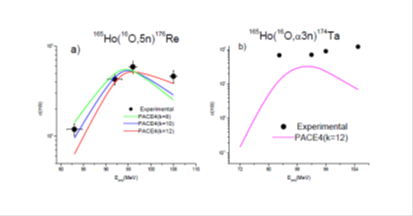
Figure 1 Sum of measured EFs for all CF channels along with PACE 4 calculations for (6O,5n)and(b)alpha-emitted channels(16O, α3n)system.
- Complete fusion of 16O,i.e.,
- Incomplete fusionof16O,i.e.,
(α –as spectator)
As can be seen from Figure 1b the experimentally measured EFs are relatively higher as compared to the theoretical predictions. Since the code PACE4 doesn’t take ICF into account, therefore the enhancement in the experimentally measured cross-sections are attributable to the contributions of ICF of 16O with 165Ho target.
For 16O + 51V system
Similarly, in 16O + 51V system values of the level density parameter (K=8, 10, 12) were varied to fit to the experimentally measured EFs for a representative non-α-emitting (16O, p4n) channel. Figure 2a displayed the experimentally measured and theoretically calculated EFs for 62Zn residue populated via (16O, p4n) channel. In this channel also there is no likelihood of ICF reaction occurring and therefore, this channel is populated only by CF process. As can be seen from this figure, the PACE4 predication with K=10, in general, reproduced satisfactorily the experimentally measured EFs. For all possible channels in the interaction 16O + 51V system, all calculations and analysis were done consistently using K=10. The measured EFs along with the PACE4 prediction for representative residue populated via α-emitting channel is shown in Figure 2b. A representative 54Mn residue may be populated through CF and/or ICF processes as:
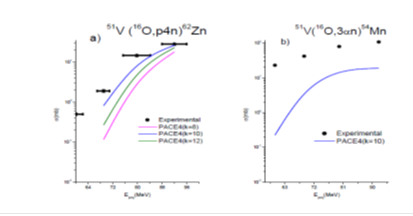
Figure 2 measured EFs for (16O, p4n) channels along with PACE4 predication and (b) alpha emitted channels for (16O,3αn)system.
- Complete fusion of 16O,i.e.,
- Incomplete fusionof16O,i.e.,
(α-as spectator)
System with 12C projectile
12C+ 128Te system
In this system also values of the level density parameter (K=8, 10, 12), were varied to fit to the experimentally measured EFs for a representative non-α-emitting (12C, 5n) channel, in this channel also there is no likelihood of ICF reaction occurring and therefore, this channel is populated only by CF process. As can be seen from Figure 3a the PACE4 predication with K=10, in general, reproduced satisfactorily the experimentally measured EFs. For all possible channels in the interaction 12C+ 128Te system, all calculations and analysis were done consistently using K=10. The measured EFs along with the PACE4 prediction for representative residue populated via-α-emitting channel is shown in Figure 3b. A representative 131Ba residue may be populated through CF and/or ICF processes as:
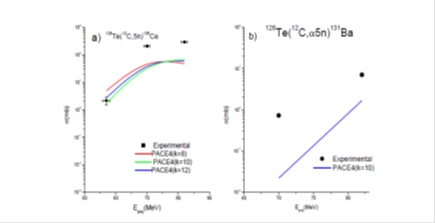
Figure 3 non-α- emitted channels for(12C, 5n) and (b) alpha emitted channels for(12C,α5n).
- Completefusionof12C,i.e.,
- Incompletefusionof12C,i.e.,
(α-as spectator)
12C+ 59Co system
Values of the level density parameter (K= 8, 10, 12) were varied to fit to the experimentally measured EFs for a representative non-α- emitting channel, (12C, 2p2n) in this channel also there is no likelihood of ICF reaction occurring and therefore, this channel is populated only by CF process. As can be seen from this Figure 4a the PACE4 predication with K=10, in general, reproduced satisfactorily the experimentally measured EFs. For all other possible channels populated in the interaction 12C+ 59Co system, all calculations and analysis were done consistently using K=10. The measured EFs along with the PACE4 prediction for representative residue populated via α-emitting channel is shown in Figure 4b. A representative 65Ga residue may be populated through CF and/or ICF processes as:
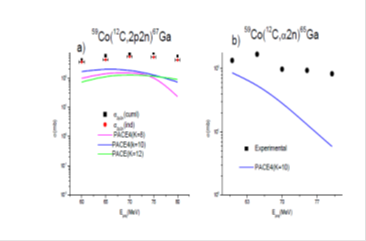
Figure 4 (a) measured EFs for (12C, 2p2n) channels along with PACE4 predication and (b) alpha emitted channels for (12C, α2n) system. )
- Complete fusion of 12C,i.e.,
- Incomplete fusion of 12C,i,i.e.,
(α-as spectators).
System with 14N projectile
14N + 128Te system
In4N + 128Te system the values of the level density parameter (K=8, 10, 12) were varied to fit to the experimentally measured EFs for a representative of-α emitting, (14N, 4n) channel. In this channel also there is no likelihood of ICF reaction occurring and therefore, this channel is populated only by CF process. As can be seen from this Figure 5a the PACE4 predication with K = 12, in general, reproduced satisfactorily the experimentally measured EFs. For all possible channels in the interaction 14N + 128Te system, all calculations and analysis were done consistently using K = 12. The measured EFs along with the PACE4 prediction for representative residue populated via α-emitting channel is shown in Figure 5b. A representative 133La residue may be populated through CF and/or ICF processes as:
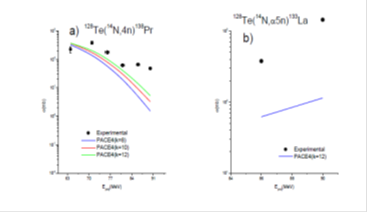
Figure 5 (a)non -alpha contaminated channels(14N, 4n) vs projectile energy and (b) alpha contaminated channel vs projectile energy(14N, α5n).
- Complete fusion of 14N,i.e.,
- Incompletefusionof14N,i.e.,
(α-as spectators).
Incomplete fusion contributions
In this section, an attempt has been made to separate the contributions of ICF in all α-emitting channels populated in the interactions of a12C, 14N and 16O projectiles with59Co,128Te,51V and 165Ho targets. The sum of the ICF cross-section for the respective systems
was assigned to the difference between the higher charged isobaric precursor decay corrected measured cross-section for possible α-emitting channels,
and the calculated cross-section
for best fitted K value. It is clearly seen in Figure 6 from (a) to (e) that ICF production cross-section
increase significantly with an increase in beam energy.
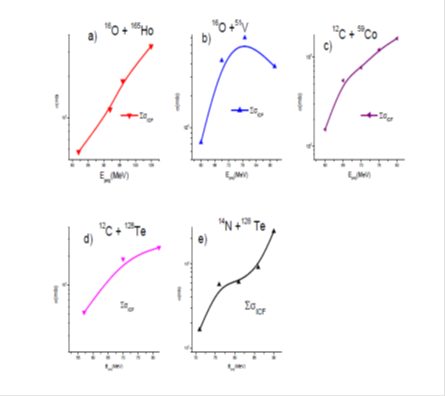
Figure 6
versus Eproj. It has been mentioned that all the α-emitting channels identified in the present systems are expected to have significant contributions from ICF reactions.
Figure 7 (a) to (e) displayed the sum of contributions coming from all ICF channels
and the sum of all CF channels
were plotted along with the total fusion cross-section
for all α and non-α emitting channels in 12C +59Co, 128Te and 16O +51V, 165Ho systems. As can be observed from these figure the CF components have dominant contribution up to≈70MeV, ≈73 MeV,≈72 MeV, and≈75MeVfor16O +51V, 14N +128Te, 12C+59Co and 12C +128Te systems, respectively, while ICF contribution seems start to influence from these points.
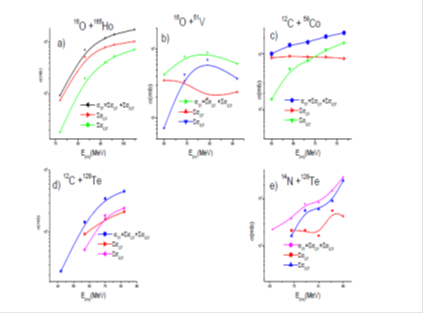
Figure 7 The total sum of the measured, σTF and the total sum of the CF cross-sections,
along with the total sum of ICF cross-sections,
atvarious energies.
Further, except for 16O +165Ho system it is clearly seen from these figures that the separation between the plots of
and
in general decreases significantly from these points onwards with an increase in projectile energy, which indicates that the ICF contribution becomes larger at higher energy points in the respective systems. This may be due to an increase in the probability of projectile break up into α-clusters 16O(12C+ α →8Be + α + α → α + α + α), 14N(10B+ α) and 12C(8Be+ α → α + α + α) as the projectile energy increases.
Incomplete fusion fraction
To study the dependence of ICF contribution on various entrance channel parameters, the percentage ICF fraction (FICF) is evaluated using the relation,
Figure 8 Displayed the graph of the calculated FICF values as a function of normalized projectile energy, (Eproj/VCB), for presently studied systems.

Figure 8 FICF values as a function of normalized projectile energy. It may be observed from this figure the incomplete fusion fraction (FICF) which represents a part of ICF contribution to all fusion processes, for all systems except 16O+51V in general smoothly increases with the increase in normalized projectile energy.
To investigate the dependence of FICF on entrance channel mass-asymmetry
, the incomplete fusion fraction, PICF is plotted in Figure 9 as a function of normalized relative velocity (Vrel/c) for presently studied systems Vrel is expressed as:
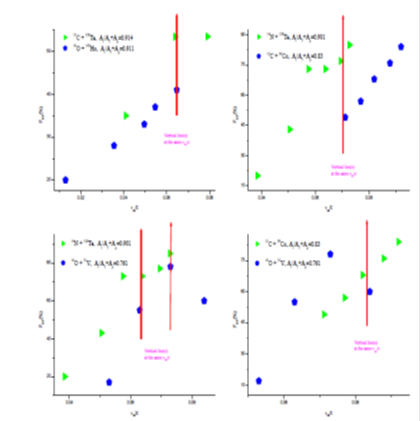
Figure 9 ICF fraction as a function of normalized relative velocity.
=
…………………………………………………(17)
µ is the reduced mass of the entrance channel.
As can be seen from Figure 9 in general, for an approximately equal value of Vrel/c (vertical lines) the value of FICF is higher for mass-asymmetric system than symmetric. It may further, however, pointed out that the probability of ICF is more in mass asymmetric than mass symmetric system, which is consistent with the systematic Morgenstern et al.13
In this study the excitation functions of residues produced in the interaction of 12C +59Co,128Te,14N +128Te and 16O +51V ,16O +16Ho system were investigated at ≈ 3-8 MeV/nucleon to probe the correlation between entrance channel properties and incomplete fusion reaction. The measured data available in the literature [14-18] were compared with the calculation done using the statistical model code PACE4. For representative non-α-emitting channel from the respective systems, the experimentally measured excitation functions, after correcting them for possible contributions from higher charger isobaric precursor decays, were in general found to be in good agreement with theoretical predictions. However, for α-emitting channels, the measured excitation functions after correcting the HCIP contribution (if any) were significantly higher than the values predicted by PACE4. These enhancements may be attributable to processes from break-up effect. For 16O +16Ho system, the estimated ICF fraction was found to be less than, 20.2% at the starting point (≈72.9 MeV), but at the highest energy point (≈105MeV) it reached approximately,41% of the total fusion cross-section. However, the ICF fraction was found to be approximately, 17.3%, 15%, 0% and 19.5% of the total cross-section at the starting point of ICF influence and reached≈60%,≈65%,≈53.42% and≈84.9%, at the highest energy point for 12C +59Co,128Te, 14N +128Te and 16O+51V, systems, respectively.
From the present investigation, it is found that the fraction of ICF increase with the increase in beam energy. Further, it may be pointed out that ICF fraction is found to be more in mass-asymmetric systems than mass-symmetric systems. Thus, it may be inferred that, in general, the ICF fraction is sensitive to the incident projectile energy and mass-asymmetry of the entrance channel. Moreover, the observation of high ICF fraction is attributable to the prompt breakup of the projectile into α-clusters where in the projectile, breaks up into 12C (8Be +4He), 14N(10B +4He) and /or12C(4He+4He+4He) leading to an ICF reaction. The present observations are thus in agreement with the Morgenstern systematic.13









